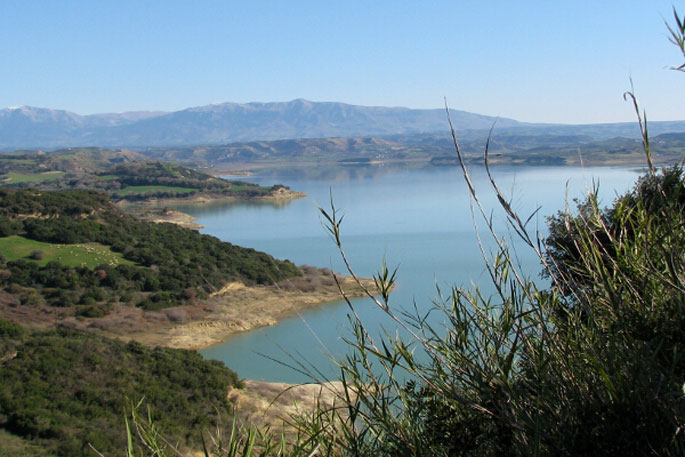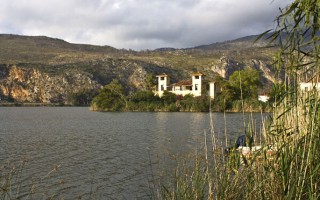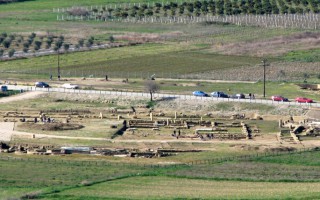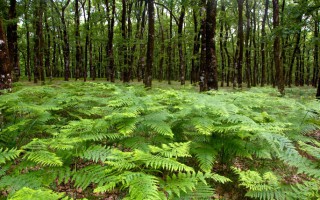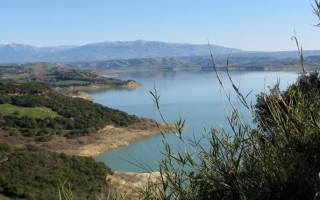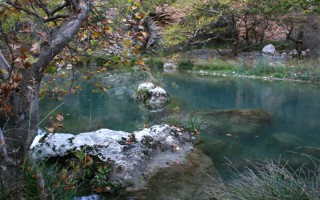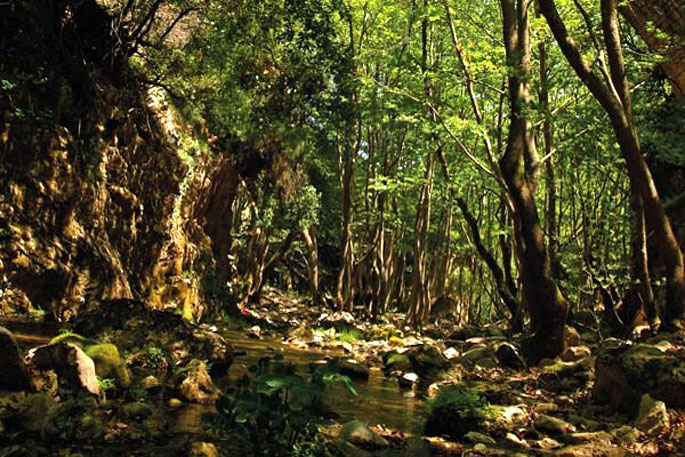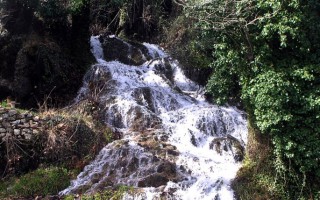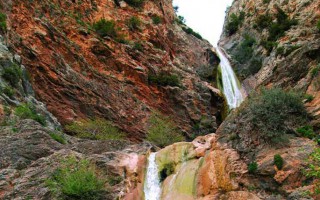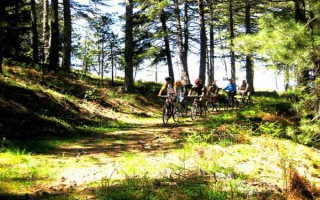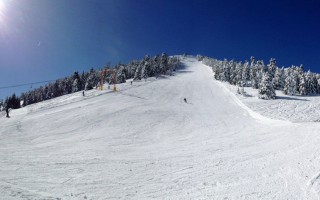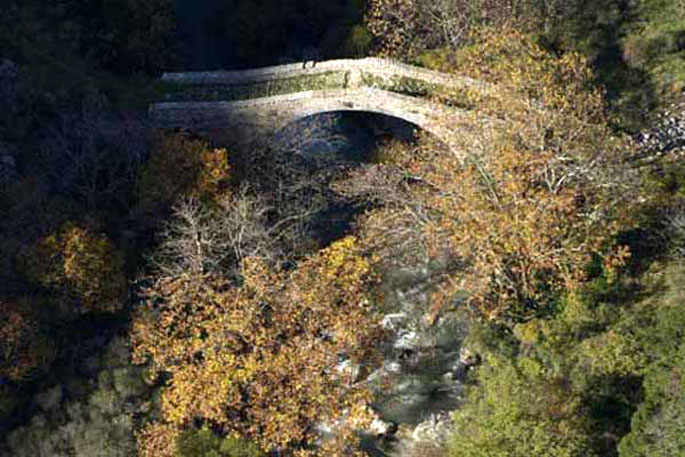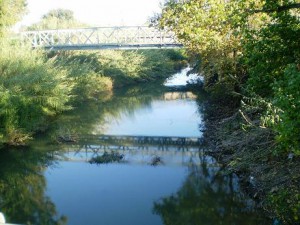 Pineios is one of the Peloponnese’s most significant rivers, its total length is 70 km. Also known as Gastouni River, it has its sources in the mount Erymanthos and empties in the Ionian Sea near town bearing the same name. According to mythology, Hercules diverted the flow of Pineios and Alfeios rivers in order to clean the Augean Stables in his fifth labor. After having demolished the stables’ walls, the hero used the river flow to clean the dung.
Pineios is one of the Peloponnese’s most significant rivers, its total length is 70 km. Also known as Gastouni River, it has its sources in the mount Erymanthos and empties in the Ionian Sea near town bearing the same name. According to mythology, Hercules diverted the flow of Pineios and Alfeios rivers in order to clean the Augean Stables in his fifth labor. After having demolished the stables’ walls, the hero used the river flow to clean the dung.
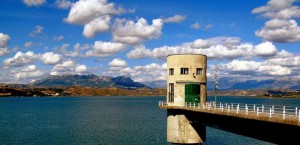 Pineios River, on its way to the sea, supplies the artificial lake of Pineios. One of Elis most important constructions completed in 1968, the dam that holds the water of the river is located close to Ancient Ilida. Its total height is 50m and it is 2,175 meters long.
Pineios River, on its way to the sea, supplies the artificial lake of Pineios. One of Elis most important constructions completed in 1968, the dam that holds the water of the river is located close to Ancient Ilida. Its total height is 50m and it is 2,175 meters long.
Source: www.mythicalpeloponnese.gr
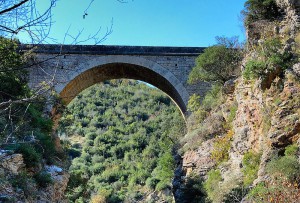 Peloponnese’s longest river (111km long) has its source in Arcadia and its mouth in the Prefecture of Elis. According to mythology, Apheus was one of the river-gods of antiquity, worshiped mainly in the regions of Arcadia, Elis and Messinia. Son of Oceanus and Tethys, he killed his brother Cercaphus and haunted by the Erinyes, he leapt into the river which was later named after him.
Peloponnese’s longest river (111km long) has its source in Arcadia and its mouth in the Prefecture of Elis. According to mythology, Apheus was one of the river-gods of antiquity, worshiped mainly in the regions of Arcadia, Elis and Messinia. Son of Oceanus and Tethys, he killed his brother Cercaphus and haunted by the Erinyes, he leapt into the river which was later named after him.
Source: www.mythicalpeloponnese.gr
Ladon is a Peloponnesian river and a tributary of Alfeios. It got its name from the homonymous river in Viotia, when the locals settled in the area around 1307 BC. Ladon is surrounded by a beautiful natural landscape, something confirmed by Pausanias.
It is a calm river, which makes it ideal for many activities, like canoe-kayak, rafting and swimming, even for small children. The lovely scenery is also ideal for hiking and trekking.
One of the most significant attractions of the area is the river’s hydroelectric dam, which was constructed in 1954 in the location Pidima, at an altitude of 420 metres. This dam created an artificial lake, whose wider area has been declared an ecological park due to its unique natural environment and the rare flora and fauna. In the area around the lake you will also have the opportunity to see the so-called “Kyras to Gefyri” (the Bridge of the Lady), which was built during the Middle Ages and is only visible during the summer months, when the waters of the dam withdraw.
River Ladon originates in the Aroania Mountains, crosses the prefecture of Achaia and flows into Alfeios, in the prefecture of Arcadia. Alfeios then flows into the Kyparissian Gulf. The largest section of the river flows between the mountains of Mainalo and Afrodisio and, as with most of the Greek rivers, it makes its appearance in the Greek Mythology.
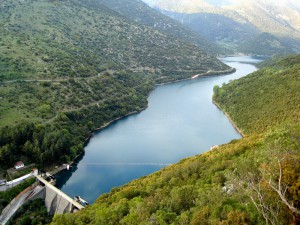 According to the Myths, Artemis was hunting on the banks of Ladon, Dimitra was swimming in its waters and Pan was wandering around, living his endless adventures. On one occasion, Pan saw and fell in love with the nymph Syrigga (Syringe) and started chasing her. Ladon, wanting to protect her, turned her into a reed. Pan cut those reeds down and created his musical instrument, the Syrinx. Ladon was also associated with the murder of Lefkippos, the son of Pisa and Oinomaos. Lefkippos fell in love with the nymph Daphne, daughter of Gaia and Ladon, or, according to another version, of Pineios from Thessaly. Daphne, however, was courted by the God Apollo. With a powerful desire to be near her, Lefkippos disguised as a woman and joined her friends. Apollo got so jealous of his presence that he inspired the nymphs to bathe, something that would force the young man to get naked as well. So, his true gender was revealed, something that enraged the nymphs, who ultimately killed him.
According to the Myths, Artemis was hunting on the banks of Ladon, Dimitra was swimming in its waters and Pan was wandering around, living his endless adventures. On one occasion, Pan saw and fell in love with the nymph Syrigga (Syringe) and started chasing her. Ladon, wanting to protect her, turned her into a reed. Pan cut those reeds down and created his musical instrument, the Syrinx. Ladon was also associated with the murder of Lefkippos, the son of Pisa and Oinomaos. Lefkippos fell in love with the nymph Daphne, daughter of Gaia and Ladon, or, according to another version, of Pineios from Thessaly. Daphne, however, was courted by the God Apollo. With a powerful desire to be near her, Lefkippos disguised as a woman and joined her friends. Apollo got so jealous of his presence that he inspired the nymphs to bathe, something that would force the young man to get naked as well. So, his true gender was revealed, something that enraged the nymphs, who ultimately killed him.
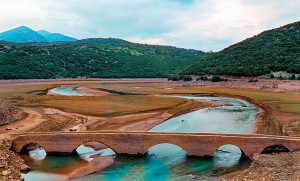 Back in nowadays, Ladon is a very quiet river, surrounded by an incredibly beautiful nature, and offers the opportunity for many activities, like rafting, canoe-kayak, swimming, fishing, hiking and mountain biking around its banks. One of the most important attractions of Ladon is its dam, which is a 104 metres long, 55 metres high, built in the location Pidima at an altitude of 420 metres. The construction of the dam started in 1950, as part of the creation of a hydroelectric power station for PPC. The project was completed 5 years later and became one of the first major power stations in Greece, while the dam was collecting about 50,000,000 cubic metres of water. An Italian company undertook its completion and the cost was covered by the reparations from World War II. The dam led to the creation of an artificial lake in a ravine of Mount Afrodisio, with a total area of 6,000 square metres, set amongst spectacular scenery. This lake was turned into an eco-park and is ideal for many activities, like boating, swimming and fishing, as well as hiking around its shores. An interesting attraction is the “Kyras to Gefyri” (the Lady’s Bridge), which was constructed in the 13th century AD and is only visible during the summer months, when the level of the waters goes down.
Back in nowadays, Ladon is a very quiet river, surrounded by an incredibly beautiful nature, and offers the opportunity for many activities, like rafting, canoe-kayak, swimming, fishing, hiking and mountain biking around its banks. One of the most important attractions of Ladon is its dam, which is a 104 metres long, 55 metres high, built in the location Pidima at an altitude of 420 metres. The construction of the dam started in 1950, as part of the creation of a hydroelectric power station for PPC. The project was completed 5 years later and became one of the first major power stations in Greece, while the dam was collecting about 50,000,000 cubic metres of water. An Italian company undertook its completion and the cost was covered by the reparations from World War II. The dam led to the creation of an artificial lake in a ravine of Mount Afrodisio, with a total area of 6,000 square metres, set amongst spectacular scenery. This lake was turned into an eco-park and is ideal for many activities, like boating, swimming and fishing, as well as hiking around its shores. An interesting attraction is the “Kyras to Gefyri” (the Lady’s Bridge), which was constructed in the 13th century AD and is only visible during the summer months, when the level of the waters goes down.
Πηγή: www.mythicalpeloponnese.gr
Lousios is a Peloponnesian river and a tributary of Alfeios. It is a relatively small river, approximately 25 kilometres long. However the landscape that surrounds it on its both banks is magical. The name of the river has ancient origins. It is said that it was given this name because the newborn Zeus was bathed (Louzo=bathing) in its waters by the nymphs Theisoa, Neda and Agno.
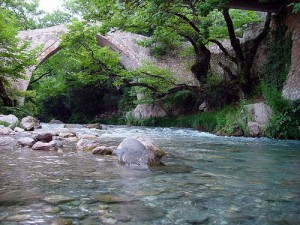 Near Karytaina, River Lousios crosses a gorge of substantial environmental importance, about 26 kilometres from its mouth. The natural beauty of this gorge fully justifies its characterization as a protected zone by the Ministry of Culture in 1997. Its flora is rich, and its fauna includes many species of reptiles, birds and even bats. There are numerous monasteries, churches and hermitages around the river, evidence of the religious life that developed there in the past.
Near Karytaina, River Lousios crosses a gorge of substantial environmental importance, about 26 kilometres from its mouth. The natural beauty of this gorge fully justifies its characterization as a protected zone by the Ministry of Culture in 1997. Its flora is rich, and its fauna includes many species of reptiles, birds and even bats. There are numerous monasteries, churches and hermitages around the river, evidence of the religious life that developed there in the past.
The gorge is ideal for a plethora of activities, like rafting and kayaking. It is a particularly impetuous river and is certainly not recommended for beginners. However, the crossing of the gorge is something suitable for everyone and a truly unique experience.
 Lousios originates in the location of the ancient town of Theisoa, near the village of Karkalou, as well as further to the north, near Kaloneri, in the location of the church of Agia Paraskevi. These two streams meet up in Karkalou, where Lousios continues its course, to end up after 25 kilometres in Alfeios and flow into somewhere near Karytaina. In its relatively short course, Lousios gives life to the entire surrounding area and dazzles with its natural beauty that includes flora, fauna, unique formations, waterfalls and an incredible gorge.
Lousios originates in the location of the ancient town of Theisoa, near the village of Karkalou, as well as further to the north, near Kaloneri, in the location of the church of Agia Paraskevi. These two streams meet up in Karkalou, where Lousios continues its course, to end up after 25 kilometres in Alfeios and flow into somewhere near Karytaina. In its relatively short course, Lousios gives life to the entire surrounding area and dazzles with its natural beauty that includes flora, fauna, unique formations, waterfalls and an incredible gorge.
 The gorge of River Lousios is one of the most impressive attractions in the prefecture of Arcadia. It is 15 kilometres long and around 2 kilometres wide. On its western side it goes through the National Trail 32, which is part of the European trail E4 GR that starts from Vytina, passing through the villages of Zygovisti, Dimitsana and Paliohori, the Monasteries of Philosophou and St. John the Baptist, then through Karytaina to end up in Gytheio. This entire area is truly amazing. The flora is rich and includes laurels, maples, willows, yews, myrtles, plane trees, elms, poplars, firs, olive trees and many more. The fauna is equally impressive, including various species of reptiles, birds, fish and mammals that live here throughout the year.
The gorge of River Lousios is one of the most impressive attractions in the prefecture of Arcadia. It is 15 kilometres long and around 2 kilometres wide. On its western side it goes through the National Trail 32, which is part of the European trail E4 GR that starts from Vytina, passing through the villages of Zygovisti, Dimitsana and Paliohori, the Monasteries of Philosophou and St. John the Baptist, then through Karytaina to end up in Gytheio. This entire area is truly amazing. The flora is rich and includes laurels, maples, willows, yews, myrtles, plane trees, elms, poplars, firs, olive trees and many more. The fauna is equally impressive, including various species of reptiles, birds, fish and mammals that live here throughout the year.
Religious and ascetic life developed on both sides of the gorge, especially during the Turkish occupation; something obvious from the existence of numerous monasteries, churches and hermitages, like the monasteries of Aimyaloi, Kalamiou, Philosophou, St. John the Baptist and the church of Agios Andreas of Gortyna. The wild beauty of the area combined with the serenity of nature were ideal for anyone who wanted to feel closer to God.
The gorge of River Lousios is perfect for many activities, like canyoning (crossing the river by various means), canoe-kayak, rafting, hiking and trekking. The hiking trails are numerous, each one with something different to offer. In 1997 the gorge was declared as an area of particular archaeological and environmental importance and was placed under the auspices of the Ministry of Culture.
Source: www.mythicalpeloponnese.gr

